BURLINGTON, ON. January 21, 2013 They were all there. Those that farm the rural part of Burlington; those people that live in the community and don’t want to see all that much change. The stop the Escarpment highway people weren’t out in force but they were there as well. The politicians that work the territory were in the room. And loads of staff people
The meeting took place in the elementary school in Kilbride and was part of the public process in figuring out how our Official Plan should be changed.
Every city in the province has an Official Plan that it must revise every five years. Some of the reviews are a “lick and a promise” and Burlington has had a few of those but this time out the city wanted to do some digging and begin asking the taxpayers just what they wanted their city to look like in 25 years.
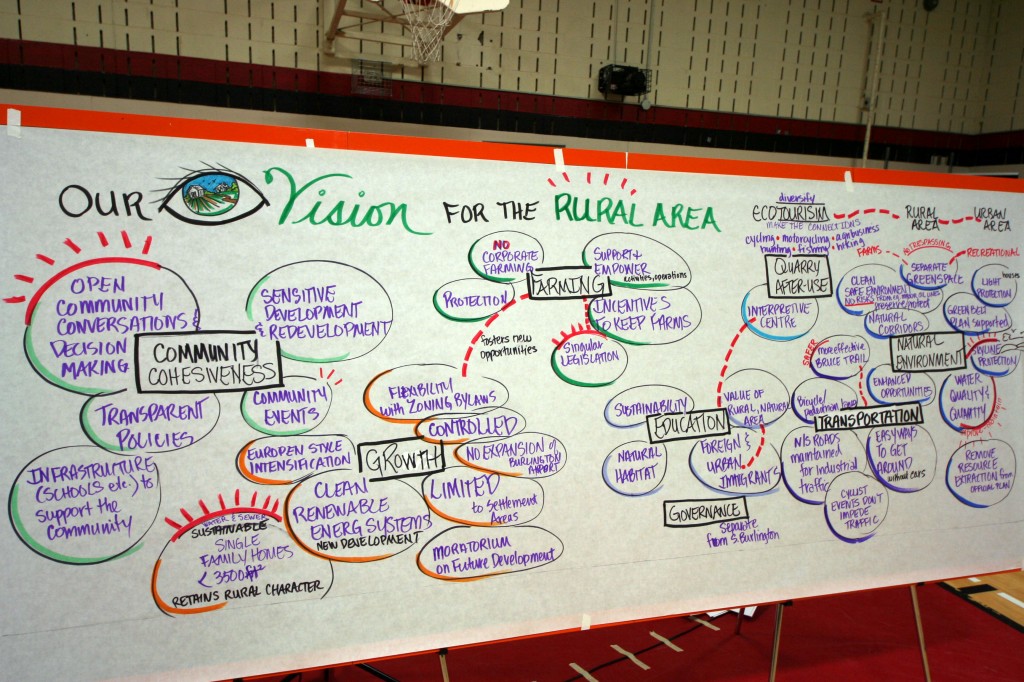
The vision for Rural Burlington as captured by a facilitator during the Rural Summit that took place at Kilbride Elementary school.
Burlington is that odd combination of a well-developed suburban community with small patches of urbaness to it and then a large swath of land to the north that is rural. There are farmers up there that actually earn a living from the land they work.
There are no dairy herds; the last of the all-purpose farms went some time ago but there are people who take off quality hay and the equestrian sector is active. Strawberry farms do a decent business as well. But there really isn’t a farming community and while many people talk about reviving that part of the economy it is not likely to happen in rural Burlington.
What is happening is the development of large properties with houses that have in excess of 5,000 square feet and both indoor and outdoor swimming pools. Some of these properties are built on 15, 25 and 40 acres properties with a portion of the land taxed as residential housing and the rest taxed as farm land – with the land rented out to local farmers who are quite content to take hay off land that they rent. No long term investment and rents that are quite reasonable.
There is a farm on the north side of Dundas that thousands of people drive by weekly without knowing there is a pear farm up there with trees that are more than 100 years old.
For those who live in north Burlington there is always the sense that the lifestyle is being threatened. There are property owners with holdings on the north side of 407/Dundas who fully expect to sell out to a developer. There are people in the Burlington Economic Development office who see opportunities to develop the north side of 407.
The Region says that isn’t going to happen and the province says it can’t happen – but things change and over time many believe that they will see encroachments on what are now rural lands.
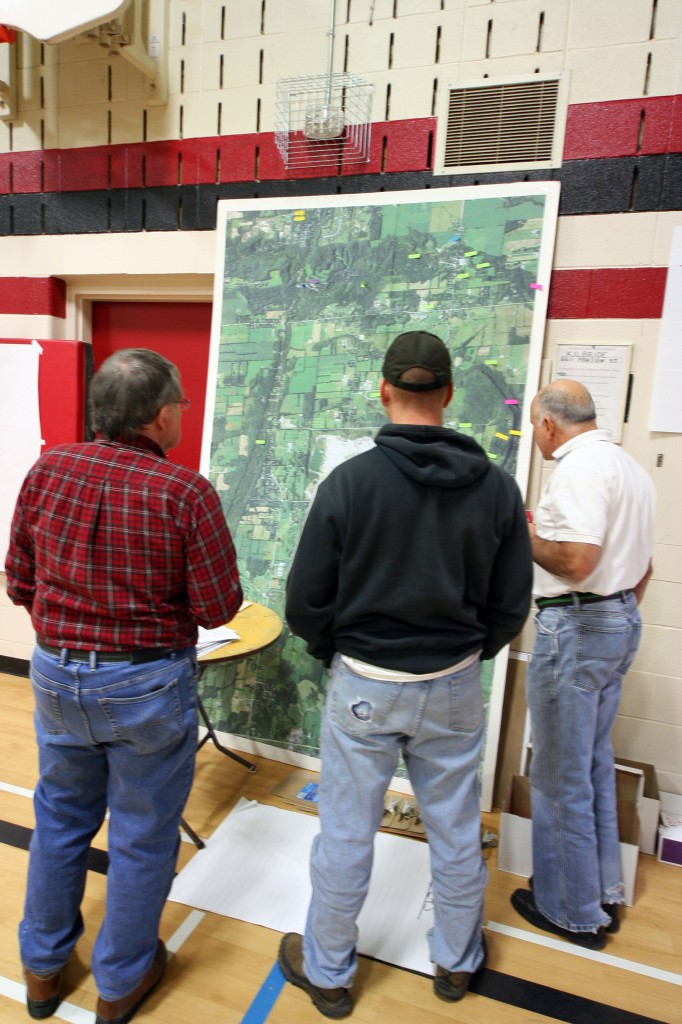
This is what rural Burlington is all about – large fields, small farms and people wanting to maintain a lifestyle.
The boundary between suburban and rural used to be Dundas Street – the Old Hwy 5. When the 407 got built that boundary shifted and we saw the Alton Village community develop.
While any Niagara to GTA road is certainly on hold for now – the province has been consistently thinking about where a road can be built to handle all the traffic that wants to get to Windsor and Niagara Falls to cross into the United States.
The bulk of what Ontario produces get shipped to the United States and much of what we consume comes from the United States and heads into that huge GTA market. To get to and from that American market trucks need roads and the QEW has just about reached its peak.
The people who do the long term economic development thinking look at the Escarpment and think they could run a road through that part of Burlington.
John Taylor who is the biggest asset the city has when it comes to fighting for rural Burlington has taken the position that what comes out of the province in terms of policy doesn’t have to become the law of the land. He firmly believes that the public can talk back and points to the success with the application to enlarge the Nelson quarry – that application was denied and while the wish on the part of the aggregate people to be able to dig out rock and ship it to Toronto hasn’t had a dagger put through its heart yet – the chances of Burlington ever seeing another quarry developed on the Escarpment are very, very slim.
What the city and the Region – include the province in that – have to do is determine just what they want to do with the existing quarry once it is mined out. There are a number of long term opportunities here that the rural community can get behind and be very proactive in determining how their community evolves.
Last Saturday some 125 people met and talked; they made notes and exchanged ideas under the guidance of a good facilitator. What she didn’t do – and many wished she had done was ask people to identify themselves – if not by name then by where they lived. It helps when one has a context into which they can put the remarks being made.
One woman wanted the community to both empower the agricultural sector and support what they want to do. The sense I got from listening was that the agriculture community doesn’t have a vision other than to be left alone. There wasn’t any comment from anyone who identified themselves as a farmer – even though there were quite a few of them in the room.
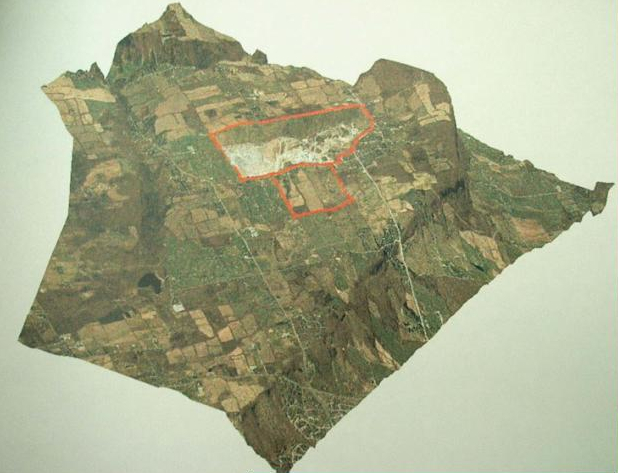
The orange outline at the top of this topographical map is where the current quarry is located. That mine is nearing being mined-out. The smaller outline is where Nelson Aggregates wanted to open a new mine. The application for a permit to do that was denied – a huge step for the rural community.
Ecotourism was mentioned several times – but other than tossing out the phrase there wasn’t much more meat on that bone. One lady suggested opening up B&B’s – great idea and there isn’t a thing stopping anyone from putting out a shingle today. But even a dozen B&B’s aren’t going to make much of a difference to the local economy or the health of the community. They won’t hurt and if done properly they would introduce more people to what we have and those visitors would speak well of our rural north.
This is the time to do that thinking and at this point there isn’t all that much quality thinking being done. Nemo 7G is in place but other than a large poster that I couldn’t make much sense out of – they’ve not come forward with very much. They do want to think ahead for seven generations – which is laudable, great if they can do it – but we’re not seeing it yet.
Environmental issues are always on the front burner for the people who live rural lives. They know what they have and they know how quickly it can be destroyed. The quarry battle has been fought and won; the Stop the Escarpment Highway battle has been fought to a win – sort of. One never knows what the bureaucrats are thinking and the people paying the bills are usually the last to know.

Ward 3 Councillor John Taylor, the person who probably works hardest to ensure that rural Burlington does not get turned into another suburb sit with John Timmis at the Lowville school house.
Taylor wants to change that and he knows that if he can mobilize the community a significant difference can be made. It takes a lot of work on the part of citizens to attend meeting after meeting and struggle to raise the funds needed to fight powerful interests. PERL (Protect Escarpment and Rural Lands) is exhausted. They won the fight to prevent Nelson Aggregate from getting another permit to quarry rock out of their holdings at Guelph Line and Colling Road but in the process burnt out a number of people who were heavily involved in the Joint Tribunal hearings that went on for close to a year. PERL won – and the community is grateful – meanwhile PERL struggles with debts and have yet to hold a community wide event to celebrate what is a truly astonishing feat.
This business of fighting powerful, well financed interests can grind you down.
One woman thought there was an opportunity to develop an “interpretive centre” on the quarry site while another related a conversation she had overheard in a coffee shop that had the owners of the Mohawk Raceway putting together plans to turn the quarry site into a resort – convention centre with an upscale hotel. That speaker wanted to see a lot more transparency in whatever gets done.
Some of the people who live in the rural community want more in the way of amenities – “there is no place to walk in Kilbride” said one woman. There are apparently no trails – just roadways.
Just about everyone wanted clean, renewable energy – but no wind turbines; solar was acceptable and geothermal was described as the best deal available.
Bike lanes on Walkers Line – a gotta for these people but not so gotta for the farmers who need to move wide equipment up and down those roads. The Bruce trail needed to make better use of the countryside – too much of the trail is along the roadway in rural Burlington.
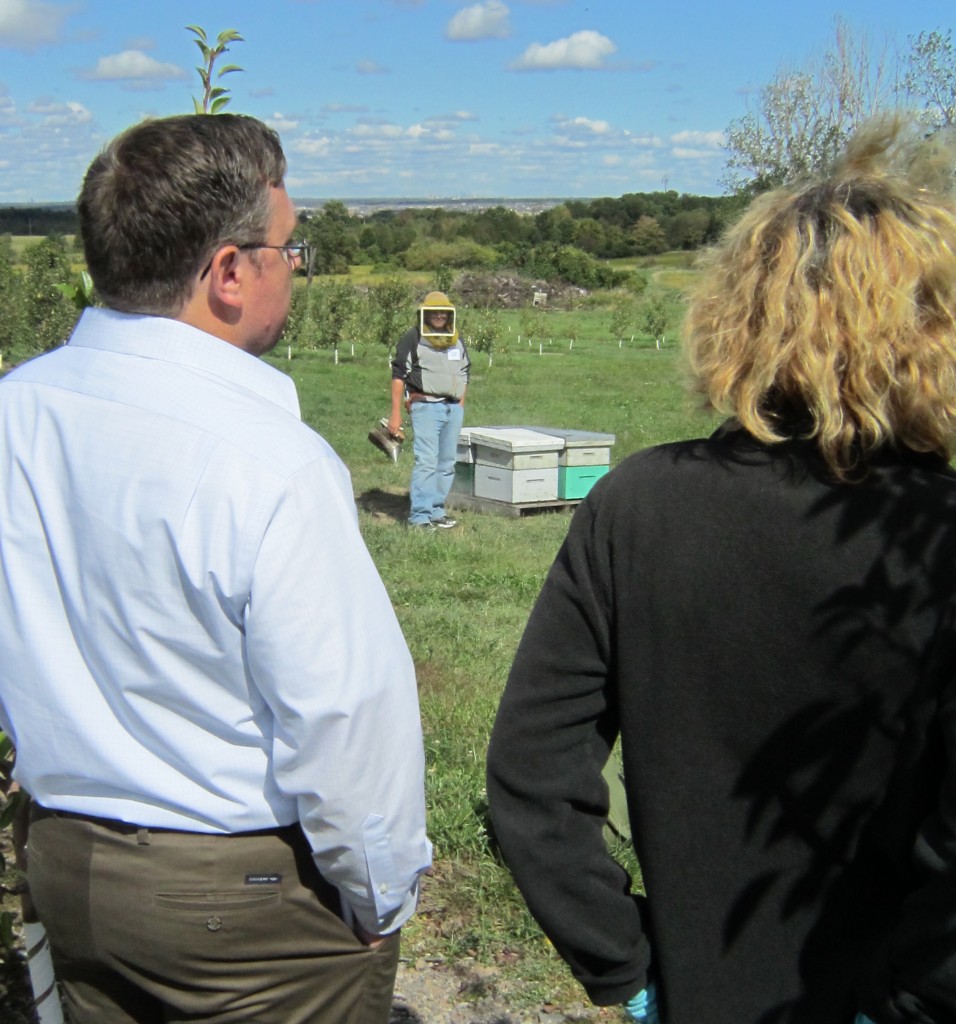
Bee keeper showing people on a farm tour how the bees are maintained and used to pollinate pear trees on a farm on the north side of Dundas just west of Guelph Line. Thousands drive by the place without knowing how big the place is.
Another speaker said there is a strong story to be told about just how economically viable rural Burlington is – with about 2000 homes in the defined area it’s difficult to see an economic core. The sum of the agricultural interest, the services the equestrian community provides, the traffic that Lowville Park attracts and the number of really small farms don’t add up to much in the way of economic activity. The biggest job creator has been the quarry. The golf courses are always busy – but are they placeholders for land that might one day get developed? Do the golf players spend money outside the grounds? The Lowville Bistro is business enough during the season and if properly marketed they could extend their season to close to year round. Is there a reason why there aren’t more decent restaurants in rural Burlington?
Someone within rural Burlington needs to do the homework to tease out the economic base – because it wasn’t at all clear there is one.
The airport can’t be allowed to grow another foot seemed to be the sentiment of the room. Milton might have something they want to say about that and the people who are building the 3500 and 5,000 square foot homes want to be able to get to that airport and fly in and out. They have truckloads of money and they want to be able to spend it on the lifestyle they have chosen – which is to live in a quiet community where they can live behind electrically operated gates and do whatever they want.
That didn’t jive with the several comments about the wish for a cohesive community. The moneyed set don’t want to be part of a cohesive community – they want to be left alone.
The day was divided into two phases with a wrap up session. City hall Planning staff would then take everything back to their offices and begin to make some sense out of it all.
The facilitator did everything they could to get people into small groups – four or five at each table, where they were asked to listen to each other while each talked about what they felt Rural Burlington would look like 20 to 25 years into the future.
A recorder took notes.
Every 20 minutes all of the people at each table, except the recorder, moved to different tables and went through the same exercise but with different people. The objective was for people to listen to each other.
With Phase 1 complete everyone had lunch, which was provided. The facilitator then went through the notes and looked for common themes. They created spaces around the school gymnasium where they put up posters on each of the six themes they had identified.
Tourism, Agriculture, Natural Environment, Transportation, Sustainable growth, Cohesive Community.
People were then invited to take their chair to the theme that interested them the most and get into a conversation with others on what the theme meant to them; what Burlington is actually doing now; what will future generations say we have achieved – then, what are the big ideas – the possible projects.
And that was about as much as one could expect from 125+ residents who met on a cold Saturday to talk about what they wanted their city to include in the next version of its Official Plan.
The city had hoped to complete its Official Plan before the end of the current term. Councillor Taylor has suggested the job may not get completed before the end of the current term of Council.
The “retirement” of a key staff member has called for a number of adjustments that were not planned.
Nisha Shirali. an environmental planner and Alison Enns, the Acting Senior Planner on this project and Andrea Smith, Acting Manager of Policy and Research now get to go back to their offices and figure out what it all means and how to work it into the review of the Official Plan.














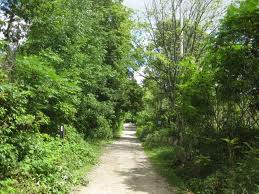







I agree with Mr Goulet. The article was poorly written, and very hard to understand. I was not at the summit, and I was hoping the article might fill in the gaps for me. It did not.
The comments about the PERL group being exhausted were irresponsible, and frankly untrue ! Those wonderful volunteers do not deserve that description.
The comment about the Lowville Bustro was unprofessional. Ms Starchuk was not looking for you to make her ” look good” but simply trying to correct your initial untrue statement.
Lets not let this article take away from the real topic of importance, preserving our beautiful escarpment for generations to come
I am disappointed in your reporting of the Burlington Rural Summit.
I thought the rural summit served was a good first start to the public’s input into the Burlington Official Plan process, and highlight the importance of Burlington’s rural area. The City is asking its citizens for input, instead of providing top down plans for public comment. Councillor Taylor and City staff should be commended for this approach to planning.
The creation and successful execution of a lasting vision takes time, patience, commitment and long term staying power. Our best cathedrals took hundreds of years to build. The comment on Nemo 7G is unfair and uninformed. I suggest you meet with Diane Gregg, who has done a great job of pulling together a good community initiative, without rushing head long onto the wrong path.
PERL committee members are not “exhausted” and its people are not “burnt out”.
PERL is not finished delivering on its mission, and our people are committed to seeing through with our mission of protecting and enhancing the Mount Nemo plateau for generations to come. Over the past 8 years, a number of PERL committee members have made important contributions; some have moved on, only to be replaced by new members with new ideas…that is a healthy organization dynamic.
There was a good cross section of urban and rural residents, including some farmers in attendance.
The economics of farming have driven many farmers off the land due to “cheap food” policies and developers assembling large parcels of land for future urban sprawl. This current reality will change with increases in future global oil prices, scarcity of future food supply, and the possible collapse of vital ecological systems.
We need to give well intentioned City planners and politicians, as well as the citizens, a chance to reinvent our society. We must believe that a better future is possible for our children and their grandchildren. We must open up possibilities by encouraging those that have the vision to lead us into an ecologically, socially and economically sustainable future. I believe!
Roger Goulet, PERL Executive Director
Great article, Pepper. I was at the summit and enjoyed it immensely. The thing I took away from the experience was how passionate people are about rural Burlington. It seems that most folks living and working up here are determined to protect this exceptional place. There is no need, in my mind, for major projects etc. other than to figure out what to do with the blasted-out quarry pit once Nelson is done with it.
I have owned the Lowville Bistro for the past six years, and was very disappointed to read your rather negatively slanted comments about my establishment! First of all, we ARE open year-round. There is a “seasonal appeal” in attracting customers to this area during the worst winter months, and my business hours simply reflect this fact (obviously, for economic reasons). I find your remark about marketing inappropriate and unnecessary in the context of this article. Have you ever even been to the Lowville Bistro? If not, I believe it behooves you to run your comments past me before publishing them – and potentially negatively impacting my business. If you knew anything about the Lowville Bistro, I believe my clientele would give a different impression of this upscale casual dining establishment in the middle of this rural gem.
Judie Starchuk
Owner, The Lowville Bistro
Editors note:
We have been to the Lowville Bistro – several times, with mixed feelings and we will return. We have also run a restaurant and know full well the size of the challenge you face. Why you “behoove” us to run our comments past you before we publish them is not what a newspaper does – public relations do that kind of thing. My job is not to make you look good – but to tell what I experience.